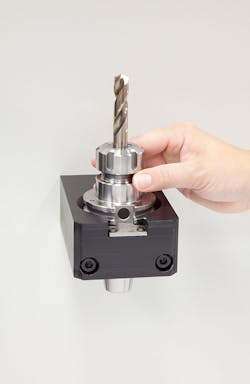Like a space capsule reentering Earth’s atmosphere, manufacturing innovations are coming in fast. For large industrial suppliers in the automotive and aerospace industries, the mission is to optimize production runs and reduce tooling costs. Increased production efficiency for CNC machines is coming from several directions, including improved work processes and increased monitoring.
In one case, a large, global jet engine manufacturer needed a way to better manage the tools used with its CNC machines. Each machine comes with 100-200 cutting tools—all of which face considerable wear and tear in the manufacturing environment.
“Aerospace components, especially those for engines, are made from materials that are extremely tough to machine,” explains Rob Caron, president of Caron Engineering, a company that develops advanced retrofit solutions for CNC machines. “Tooling breaks down at a much higher rate with these tougher and expensive materials, making it more difficult to determine how fast the tool can go without causing damage to the material.”
Wells, Maine-based Caron Engineering equips many component suppliers with its Tool Monitoring Adaptive Control (TMAC) System, which monitors true motor power, vibration or strain in real time to determine if a tool is worn or broken. Other monitoring includes coolant flow and pressure, and spindle speed.
TMAC can monitor multiple tool paths simultaneously. “For aerospace manufacturing, CNC machine tools can have more than 200 tools, with as many as three operating simultaneously," Caron says. “Tracking each one’s use and history via a manual operation takes a lot of time and is prone to errors.”
A new custom system from Caron Engineering, ToolConnect, focuses on automating processes for operators at the CNC machine level by way of automating the transfer of tool presetter data to the machine control. The automated data collection system—either as a standalone tool or combined with TMAC—uses a Siemens Simatic Ident RFID system to read and write tool data. The RF250R high-frequency RFID reader operates at 13.56 MHz to read and transmit tag data rapidly across short distances to the ToolConnect system.
Power to the operator
With so many cutting tools for each machine, the aerospace manufacturer wanted to remove manual entry of dimensions, usage and histories. Each tool is preset with the required measurements and tool capability needed to cut components for a jet engine accurately.
Before the introduction of ToolConnect, operators entered the tool’s preset information via a keyboard during the loading of a tool into a CNC machine. This manual step was a time-consuming process that was prone to errors and lacked tracking for real-time status of the tool once it’s removed from the machine.
The tool presetter writes data to the RFID tag embedded in the tool holder. To transfer presetter data of a specific tool, a CNC operator on the aerospace manufacturer’s shop floor puts the tool’s holder in an RFID read station, called a tool pot. Once in the tool pot at the CNC machine, the tag is read by ToolConnect.
The operator can view prompts and status information via Siemens’ human-machine interface (HMI) Comfort Panel. The data includes the tool’s custom assembly number for tracking; measurement data, including length, weight, diameter, radius, etc.; and tool life data written to and from the RFID tag by ToolConnect.
The DIN 69873 RFID tags are circular in design, measuring 10 mm in diameter and 4.5 mm thick. A Siemens 8 mm Simatic Ant8 external radio antenna enables ToolConnect to span a wide range of tools. “The smallest antennas from other suppliers are 12 mm,” Caron says. “By being 30 percent smaller, the 8 mm antenna expands the range of tools we can cover with our ToolConnect system.”
With some types of CNC machines, ToolConnect can also automatically index to the correct magazine position to begin cutting. Other features include use of the MTConnect open standard protocol for sharing tool data between machines or enterprise platforms, as well as other CNC controllers from Okuma, Fanuc, Heidenhain, Mitsubishi and others. For this application, the aerospace manufacturer uses Sinumerik CNC controllers.
“At this point, it’s too soon to say how much time or cost the ToolConnect is saving our customer or to compare frequency of tool breakage,” Caron says. “However, the CNC operators can focus more on the quality of their output, while keeping production moving and not be worried about scrapping an expensive part due to data entry errors.”

